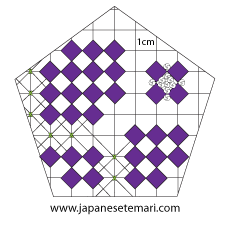Rosemary stitched this C10 division with silk ribbon. She said, "I have just uploaded 2 photos to the flower sampler folder. One is a closeup of the roses. I chose roses for October because that is the month of the Rose Festival in East Texas--probably not a month for roses in other parts of the country, but here they are splendid then. The other photo shows the camellia for January (at the top), pansy for March, and Iris for April.
The 36 cm mari was wrapped in RAINBOWS SUPERIOR #849 (sand castle) thread and marked with eighth inch bamboo caning strips. All flowers are done in silk ribbon embroidery, but what I'm most proud of, is the marking with bamboo.
As I mentioned before, the challenge was both frustrating and exciting. I just loved doing it. I did a lot of sailing down the RIO ADIR! (that's my acronym for Rip It Out And Do It Right.) but overall I'm very pleased."
This Texas gal has been stitching temari for only a few years. Last year, she passed both Level 1 and Level 2 certification for the Japanese Temari Association. For Level 2, she demonstrated her ability to stitch temari and to write patterns using correct terminology by submitting patterns for six different temari. With this original design for the flower temari challenge, she is well on the way toward Level 3 which requires eight original patterns. Way to go, Rosemary!
 |
| Rosemary photographed by the Mineola Monitor |
Thanks for being a part of TemariChallenge, Rosemary. You are an inspiration to us all and I'm happy to have found you as a kindred sister.
.....
Kindred (adjective): having the same belief, attitude, or feeling.
Sister (noun): a female friend regarded as a sister.
.....





























